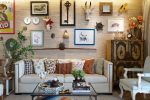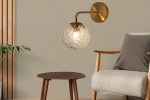Decorative lighting refers to the use of lighting fixtures and techniques to enhance the aesthetic appeal of a space. It is an essential element in interior design as it can transform a room from ordinary to extraordinary. Decorative lighting not only provides illumination but also adds character, ambiance, and style to a space. It can create a focal point, highlight architectural features, and set the mood for different activities.koozilla
Creating a Sparkling Ambiance with Chandeliers
Chandeliers are one of the most popular types of decorative lighting fixtures. They come in various styles, sizes, and materials, allowing you to find the perfect chandelier for your space. From traditional crystal chandeliers to modern and minimalist designs, there is a chandelier to suit every taste and interior style.
When choosing a chandelier for your space, consider the size of the room and the height of the ceiling. A large chandelier with multiple tiers and arms would be suitable for a grand foyer or dining room with high ceilings, while a smaller chandelier with a simpler design would work well in a bedroom or bathroom.
Maintenance and cleaning of chandeliers are important to keep them looking their best. Regular dusting with a soft cloth or feather duster can help prevent dust buildup. For more thorough cleaning, you can use a mixture of mild soap and water or glass cleaner. Be sure to turn off the power before cleaning and avoid using abrasive materials that could scratch or damage the surface of the chandelier.
The Art of Layering Lights for a Luxurious Look
Layering lights is an effective technique to create depth and dimension in a space. It involves using different types of lighting fixtures at varying heights and angles to achieve a balanced lighting scheme. By combining ambient, task, and accent lighting, you can create a luxurious look that is both functional and visually appealing.
In living rooms and bedrooms, a combination of overhead lighting, table lamps, and wall sconces can be used to create a warm and inviting atmosphere. Task lighting, such as reading lamps or pendant lights, can be added to provide focused illumination for specific activities. Accent lighting, such as spotlights or picture lights, can be used to highlight artwork or architectural features.
To create a balanced lighting scheme, consider the function of each space and the activities that will take place there. For example, in a kitchen, you may need bright task lighting for food preparation areas, while in a dining room, you may want softer ambient lighting for a more intimate atmosphere. Experiment with different combinations of lighting fixtures to find the perfect balance for your space.
Using Accent Lighting to Highlight Art and Architecture
Accent lighting is a technique used to draw attention to specific objects or areas in a space. It can be used to highlight artwork, architectural features, or decorative elements. Accent lighting fixtures are typically smaller and more focused than other types of lighting fixtures.
There are several types of accent lighting fixtures to choose from, including track lights, recessed lights, and picture lights. Track lights are versatile and can be adjusted to direct light where it is needed. Recessed lights are discreet and can be installed flush with the ceiling or wall. Picture lights are specifically designed to illuminate artwork and can be mounted above or below the artwork.
When positioning accent lights, consider the angle and distance from the object you want to highlight. Experiment with different positions to find the most flattering and effective lighting effect. Avoid placing accent lights too close or too far away from the object as it may create unwanted shadows or glare.
Creating a Cozy Atmosphere with Warm Lighting
Warm lighting refers to light sources that emit a soft, yellowish glow similar to that of candlelight or incandescent bulbs. It creates a cozy and inviting atmosphere that is perfect for relaxation and unwinding. Warm lighting can be achieved through the use of warm-colored light bulbs, such as those with a color temperature of 2700K to 3000K.
There are several types of warm lighting fixtures to choose from, including table lamps, floor lamps, and wall sconces. These fixtures can be placed strategically to create pools of warm light and add a touch of intimacy to a space. In bedrooms and living rooms, warm lighting can be used to create a cozy reading nook or a relaxing ambiance for movie nights.
When choosing the right color temperature for your space, consider the function and mood you want to create. Warmer color temperatures are more suitable for spaces where relaxation and comfort are desired, while cooler color temperatures are better for areas where focus and productivity are important.
Transforming Outdoor Spaces with Decorative Lighting

Decorative lighting is not limited to indoor spaces; it can also be used to enhance the beauty and functionality of outdoor areas. Outdoor lighting fixtures are designed to withstand the elements and provide illumination for pathways, gardens, patios, and other outdoor spaces.
There are several types of outdoor lighting fixtures to choose from, including wall sconces, post lights, and string lights. Wall sconces can be mounted on exterior walls to provide both ambient and accent lighting. Post lights can be installed along pathways or driveways to guide guests safely to your door. String lights can be hung above outdoor seating areas or wrapped around trees or pergolas to create a magical atmosphere.
When planning your outdoor lighting scheme, consider the purpose of each area and the activities that will take place there. For example, you may want brighter lighting near entrances and pathways for safety and security, while softer lighting can be used in seating areas for a more relaxed ambiance. Be sure to choose outdoor lighting fixtures that are rated for wet or damp locations to ensure their durability.
Incorporating Color into Your Decorative Lighting Scheme
Color can be a powerful tool in interior design, and it can also be used to enhance your decorative lighting scheme. Colored light bulbs and filters can be used to create a mood or add a pop of color to a space. They can be used to highlight architectural features, create focal points, or simply add visual interest.
There are several ways to incorporate color into your decorative lighting scheme. Colored light bulbs are available in a wide range of colors, including red, blue, green, and purple. They can be used in pendant lights, chandeliers, or wall sconces to create a dramatic effect. Colored filters can be placed over existing light fixtures to change the color of the light emitted.
When choosing the right color for your space, consider the overall color scheme and the mood you want to create. Warm colors, such as red and orange, can create a cozy and intimate atmosphere, while cool colors, such as blue and green, can create a calm and soothing ambiance. Experiment with different colors and combinations to find the perfect match for your space.
Making a Statement with Unique Light Fixtures
If you want to make a bold statement in your space, consider incorporating unique light fixtures into your decorative lighting scheme. Unique light fixtures can serve as focal points and conversation starters, adding personality and style to any room.
There are several types of unique light fixtures to choose from, including pendant lights, chandeliers, and wall sconces. These fixtures come in various shapes, sizes, and materials, allowing you to find the perfect statement piece for your space. From oversized industrial-style pendant lights to whimsical and colorful chandeliers, there is a unique light fixture to suit every taste.
When choosing a statement piece for your space, consider the overall style and theme of your interior design. A modern and minimalist space may benefit from a sleek and sculptural pendant light, while a vintage-inspired room may call for a retro chandelier. Be sure to choose a unique light fixture that complements your existing decor and adds visual interest without overwhelming the space.
Maximizing Space with Creative Lighting Solutions
Lighting can play a crucial role in maximizing the perceived space in a room. By using lighting techniques and fixtures strategically, you can create the illusion of a larger and more open space. This is especially important in small rooms or areas with limited natural light.
One way to create the illusion of space is by using recessed lighting. Recessed lights are installed flush with the ceiling or wall, creating a clean and streamlined look. They provide ambient lighting without taking up valuable floor or wall space. By evenly distributing recessed lights throughout the room, you can create a sense of openness and spaciousness.
Another way to maximize space is by using mirrors in conjunction with lighting fixtures. Mirrors reflect light and create the illusion of depth, making a room appear larger than it actually is. By placing mirrors strategically opposite windows or light sources, you can bounce light around the room and create a brighter and more expansive feel.
Tips for Choosing the Right Decorative Lighting for Your Home or Business
When choosing decorative lighting for your home or business, there are several factors to consider to ensure you make the right choice.
Firstly, consider the purpose of the space. Different areas require different types of lighting. For example, task lighting is important in areas where specific activities take place, such as kitchens or offices. Ambient lighting is important in areas where general illumination is needed, such as living rooms or hallways. Accent lighting is important in areas where you want to highlight specific objects or features, such as artwork or architectural details.
Secondly, consider the size and style of the lighting fixtures. The size of the fixture should be proportionate to the size of the room. A large chandelier in a small room may overwhelm the space, while a small pendant light in a large room may get lost. The style of the fixture should also complement the overall design and theme of the space. For example, a modern and minimalist space may call for sleek and simple fixtures, while a traditional space may call for more ornate and decorative fixtures.
Lastly, consider working with a professional to create a cohesive lighting scheme. A lighting designer or interior designer can help you choose the right fixtures, plan the layout, and create a balanced lighting scheme that meets your needs and enhances the beauty of your space. They can also help with installation and ensure that all electrical and safety requirements are met.
In conclusion, decorative lighting is an essential element in interior design. It can transform a space from ordinary to extraordinary by adding character, ambiance, and style. Whether you are creating a sparkling ambiance with chandeliers, layering lights for a luxurious look, highlighting art and architecture with accent lighting, creating a cozy atmosphere with warm lighting, transforming outdoor spaces with decorative lighting, incorporating color into your lighting scheme, making a statement with unique light fixtures, maximizing space with creative lighting solutions, or choosing the right decorative lighting for your home or business, there are endless possibilities to explore. With careful consideration and planning, you can create a lighting scheme that not only illuminates your space but also enhances its beauty and functionality.




